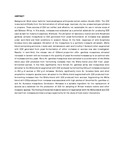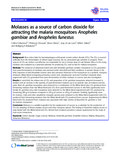| dc.contributor.author | Mweresa, Collins K | |
| dc.contributor.author | Omusula, Philemon | |
| dc.contributor.author | Otieno, Bruno | |
| dc.contributor.author | van Loon, Joop JA | |
| dc.contributor.author | Takken, Willem | |
| dc.contributor.author | Mukabana, Wolfgang R | |
| dc.date.accessioned | 2014-07-04T09:02:55Z | |
| dc.date.available | 2014-07-04T09:02:55Z | |
| dc.date.issued | 2014 | |
| dc.identifier.citation | Malaria Journal 2014, 13 :16 | en_US |
| dc.identifier.uri | http://www.biomedcentral.com/content/pdf/1475-2875-13-160.pdf | |
| dc.identifier.uri | http://hdl.handle.net/11295/71803 | |
| dc.description.abstract | Background:
Most odour baits for haematophagous arthropods contain carbon dioxide (CO2). The CO2 is sourced
artificially from the fermentation of refined sugar (sucrose), dry ice, pressurized gas cylinders or propane. These
sources of CO2
are neither cost-effective nor sustainable for use in remote areas of sub-Saharan Africa. In this study,
molasses was evaluated as a potential substrate for producing CO2
used as bait for malaria mosquitoes.
Methods:
The attraction of laboratory-reared and wild
Anopheles gambiae
complex mosquitoes to CO2
generated from yeast-fermentation of molasses was assessed under semi-field and field conditions in western Kenya. In the
field, responses of wild Anopheles funestus
were also assessed. Attraction of the mosquitoes to a synthetic mosquito
attractant, Mbita blend (comprising ammonia, L-lactic acid, tetradecanoic acid and 3-methyl-1-butanol) when
augmented with CO2 generated from yeast fermentation of either molasses or sucrose was also investigated.
Results: In semi-field, the release rate of CO2and proportion ofAn. gambiae
mosquitoes attracted increased in tandem with an increase in the quantity of yeast-fermented molasses up to an optimal ratio of molasses and dry
yeast. More An. gambiae mosquitoes were attracted to a combination of the Mbita blend plus CO2
produced from fermenting molasses than the Mbita blend plus CO2
from yeast-fermented sucrose. In the field, significantly more
female An. gambiae sensu lato mosquitoes were attracted to the Mbita blend augmented with CO2
produced by fermenting 500 g of molasses compared to 250 g of sucrose or 250 g of molasses. Similarly, significantly more
An. funestus Culex and other anopheline mosquito species were attracted to the Mbita blend augmented with CO2 produced from fermenting molasses than the Mbita blend with CO2
produced from sucrose. Augmenting the Mbita blend with CO2produced from molasses was associated with high catches of blood-fed
An. gambiae s.l. and An. funestus mosquitoes.
Conclusion:
Molasses is a suitable ingredient for the replacement of sucrose as a substrate for the production of
CO2 for sampling of African malaria vectors and other mosquito species. The finding of blood-fed malaria vectors in
traps baited with the Mbita blend and CO2 derived from molasses provides a unique opportunity for the study of
host-vector interactions. | en_US |
| dc.language.iso | en | en_US |
| dc.publisher | University of Nairobi | en_US |
| dc.subject | Carbon dioxide, Sugar, Sucrose, Molasses, Anopheles gambiae , Anopheles funestus , Malaria, Mosquitoes, Attraction, Behaviour | en_US |
| dc.title | Molasses as a source of carbon dioxide for attracting the malaria mosquitoes Anopheles gambiae and Anopheles funestus | en_US |
| dc.type | Article | en_US |
| dc.type.material | en | en_US |


